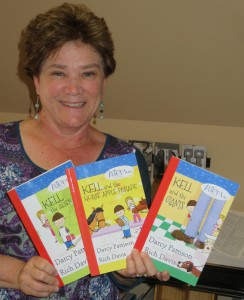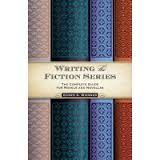Find Darcy Pattison Books in the iBook Store
As a hybrid author, I have one foot each in two very different worlds. I am traditionally published and as an author/publisher, I release my own books.
The worlds operate at tangents to each other and one point of contention is this question: how long does it take you to write a novel? Independent author Dean Wesley Smith has recently finished a year of blogging about his daily output, which includes emails, blog posts, novels and short stories. For example in June, Smith wrote 52,800 words of fiction, 14,700 nonfiction, 14,000 for blog posts, and 827 emails of about 22,900 words, for a grand total of 105,200 words.
However, traditionally published authors often agonize over a novel for two or three years. Or more.
Let’s just ask the question straight out? Which method of writing produces great novels? Both.
And don’t let anyone convince you otherwise! Not editors and not indies.
Then why is there such a wide range of discussion on the merits of the two viewpoints on the speed of writing?
Fast or Slow? From the Business POV
From a Traditional-POV, publishers generate over 50% of their income on their backlist, books that continue to sell 1000 copies a year and do so year-after-year. Yes, they need to add new books each year, but because their income isn’t starting at zero, they can be very selective in adding new books. Another strength of traditional publishers is that they have multiple sources of new stories each year, i.e. multiple authors. In fact, they will seldom put all their eggs in one basket, especially not yours. If you write quickly, a publisher will only take ONE of your mss in any given year, at least until you build a stellar reputation.

Writing the Aliens, Inc series was fast! Each book took a month to write and after comments, a week to revise. By contrast, a middle grade novel might take me a year to write.
By contrast, from a Business-POV, indie author/publishers need to write quickly. They need to quickly build a backlist that generates an ongoing income. One-book-wonders, or authors who only write one book every five years, would be foolish to go indie. Let’s say you need $1000 income from your books each month. If you only have one book out that one book MUST generate $1000 month-after-month. If, however, you have ten books out, each book must AVERAGE only $100 in sales, month-after-month. In any given month, Book 3 might sell zero and Book 9 might sell $1000. The key is that the books must AVERAGE only $100. If Book 5 contributes only $50, but does it consistently, month-after-month, that’s a valuable book for you. For a traditional publisher, though, that’s not enough income generated and they would put it out of print. (And some publishers are more wont to cut the lower producing books than others.)
Traditional publishers source stories from multiple sources, spreading the risk among many authors. Indie author/publishers have only one source of stories, and they must maximize their output.
Fast or Slow? From the Creative POV

As my grandchildren are learning to walk and run, it’s tempting to compare the age at which they take that first step. NOT FAIR! Each child–like each novel you write–develops at its own pace. Comparison does nothing but add unnecessary anxiety.
Thus, you’ll hear editors saying, “Take your time. Get it right.”
Of course, editors advise writers to slow down. They can’t handle ten books from you in one year. If you write ten in a year, you’ll likely need 5-10 publishers (if you can find them), at least until you build that reputation for blockbuster sales.
Is there value in slowing down? Yes and no. Yes, it’s good to take the time to write well. Speed CAN lead to sloppiness, but it doesn’t necessarily. On the other hand, if your normal writing speed is fast, and you manage to turn out good stories, then slowing down feels like being hobbled. For some, it’s boring to write slow and only work on one project at a time.
The Indie world emphasizes the need for speed. Dean Wesley Smith once asked a group of writers how many words they write in an hour. I shrugged. I could easily write a 1000-words in an hour. Then he suggested that I should be writing 8000 words/day, which would be 192,000 words or about 4 middle-grade novels (or two full-length adult novels) per month.
Wait. Does that math work? Yes.
But it’s also not that easy. When I know what I want to write—such as this blog post—I can easily turn out 1000 words per hour. But writing a novel is a different task. I like the analogy of a spider spinning a web. From her gut, she must create the raw materials of spider web silk, and then like an architect, she lays in the foundations of her web, hanging for her life from that slender silk while she does so. Once the foundation threads are laid, she spins more silk—from her very gut—and weaves a circular web on that foundation. She then lies in wait for a victim to arrive.
Novelists spin characters and conflicts from their very guts and soul. We lay in the foundation of a novel’s plot, and then spin a story around that foundation. Finally, we lay in wait for a reader to be captured by the story.
Once I get a foundation laid, I can spin out that 1000 words per hour. It’s that first part, creating the story’s silk from my very soul, that is hard. As the creator of the Novel Revision Retreat, I also understand the imperative of revising multiple times to get a story right. I teach and practice that a first draft tells you what the story is; the following drafts are for finding a way to tell the story in the most dramatic way possible to hold readers’ attention.
My feet are firmly in both worlds. I need to produce works so I can build my indie backlist and thus up my income levels. However, I also understand that my process is slower than I’d like.
I am working on various ways to boosting productivity, such as learning Scrivener. But in the end, I’m left somewhere in the middle, and I don’t think it’s a matter of straddling the fence.
Honor Your Own Process
Instead, I think I am honoring my own process. For blog posts and picture books, I can and do write fast. But for novels, the thinking process is much slower than my ability to type. MUCH slower. It might take me six to twelve months to do this next novel. I refuse to be intimidated by the Indie crowd into going faster. Likewise, one of the appeals of being a hybrid or indie author is that no one can force me to slow down. I don’t have to wait a year for an editor to get back to me with revision notes. I don’t have to wait for an editor who promises a contract for fourteen months, and then rejects the novel, sending me into a new round of hopeful submissions.
Slow writing doesn’t equal good.
Slow writing doesn’t equal bad.
Fast writing doesn’t equal good.
Fast writing doesn’t equal bad.
Instead, I will write at the pace each piece of work demands and allows.
Working with Deadlines
There will always be the Tyranny of the Urgent. This week I’ll be going to North Andover, MA to teach a Novel Revision Retreat and that means I must have the teaching materials done by Wednesday. That’s my writing focus this week.
Fortunately, other deadlines loom in the future and those deadlines will demand that other projects consume my attention. For traditional publishers, the deadlines are few and far between. For indie publishing, I need to have books come out about six months before publication so they can be sent for review. Can I delay a book a month? Easily. But I try to set a publication date and stick with that. It’s a business thing.
Some argue that if you can write quickly under a deadline, then you could do it anytime. Not for me. Because a deadline FOCUSES my writing and writing time in a way nothing else can do.
In other words, external deadlines also affect my output. I still honor what a piece of writing demands, but at the back of my mind, I know what that demand is. And when I add that to the deadlines, I can instinctively allow more or less time before a deadline for that piece.
Do You Work Fast or Slow?
Good. Write at the pace that works for you for any particular project.
Learn from productivity tips and use whatever software is most productive for you. Don’t be intimidated by editors who demand slow work, or contemporaries who rave about the benefits of writing fast. In the midst of the swirl of opinions, write. Your way. Your stories. As David Bayles and Ted Orland say in Art and Fear, “Your job is to learn to work on your work.” I’ll add: And do it at your own pace.

START YOUR NOVEL
Six Winning Steps Toward a Compelling Opening Line, Scene and Chapter

- 29 Plot Templates
- 2 Essential Writing Skills
- 100 Examples of Opening Lines
- 7 Weak Openings to Avoid
- 4 Strong Openings to Use
- 3 Assignments to Get Unstuck
- 7 Problems to Resolve
The Math adds up to one thing: a publishable manuscript.
Download a sample chapter on your Kindle.
Periodically, I have to refocus. What am I doing with my time? Is that what I want to do with my time? What have I accomplished this year? It’s one of those times for me and I need to refocus big time.
It’s easy to be swept up in Social Media: Facebook, Pinterest, Twitter, YouTube, and even dipping my toes into doing a podcast for the Ultimate Shrunken Manuscript. My head is full of social media how-tos and tips. This fall, I am planning a series, 30 Days to an Author’s Platform. (If you have questions or suggestions, please add them to the comments!)
But I haven’t written much fiction lately.
The reasons are complicated:
- I am feeling vulnerable, worrying that the publishing world doesn’t like my stories and won’t like this next one, if I write it. (How many of you are with me on THAT one?)
- The industry is changing in confusing ways. Possibilities abound that even a year ago were unthinkable. Read this interesting post about the emotional stages a writer goes through on the journey of becoming an indie writer or a hybrid writer. (Is that a new term for you? A hybrid author is someone who publishes with traditional publishers and self-publishes other stories. I am already a hybrid author–where do I go from here?)
- Of course, there are personal and family situations ongoing that always affect our writing. But that’s personal.
But in the end, writers write.
If I am a writer of fiction and nonfiction, then I must write. Forget the fear, forget the market, forget the personal issues. What story must I tell next?
But, what if I wanted to cross genres and write an adult novel instead? What if I wanted to write a mystery, instead of fantasy? What if I wanted to write a picture book that I know no one will buy, but I just want to tell it? No, no, no. Wrong questions.
What is the next story that I need to tell? Tell it. Get the words on paper.
THEN, worry about marketing and the reaction of the world to what I write. Come on, Darcy. Write. And if YOU need a cheerleader, I say this to you, too. Write!
What I’ve Done to Get Back to Writing

My writing office in the attic of a 3-story Victorian house.
But you want something practical? OK, here’s a couple things I’ve done.
- Encourage writing by changing the environment. Cleared off my desk. Instead of a crush of papers and notes about social media tasks, there’s nothing there but what I need to write fiction.
- Encourage writing by changing the environment. I have also decided not to check email or online accounts in the mornings.
- Encourage writing by enlisting friend’s help. I decided to attend a Master Class in July, partly to reconnect with some writing friends and get pumped up with new ideas. I expect that I will be challenged, provoked, angered, delighted and more. I will come back writing stronger than ever.
- Encourage writing by setting goals. I plan to have a new series plotted by September 1.
 Encourage writing by learning/trying something new. Because I want to write a series, I have bought a couple new books and I am working through the worksheets. Karen S. Weisner’s book, Writing the Fiction Series: The Complete Guide for Novels and Novellas has worksheets that lay out the process of doing a series. Are they perfect? No. Are they useful? Definitely. I don’t have to think as hard about structure and what to do next. It automates the process, so I can focus on the stories. The worksheets are getting me going and will keep me going for a while. And I’ll try her other book, First Draft in 30 Days.
Encourage writing by learning/trying something new. Because I want to write a series, I have bought a couple new books and I am working through the worksheets. Karen S. Weisner’s book, Writing the Fiction Series: The Complete Guide for Novels and Novellas has worksheets that lay out the process of doing a series. Are they perfect? No. Are they useful? Definitely. I don’t have to think as hard about structure and what to do next. It automates the process, so I can focus on the stories. The worksheets are getting me going and will keep me going for a while. And I’ll try her other book, First Draft in 30 Days. - Asking for encouragement. Ok. Encourage away. And encourage ALL your other writing friends this week, too. I am sure they need it, too. Just like you do. We can do it. Let’s write!



By Michelle Rafferty
After a nice little afternoon in Central Park yesterday, I consulted the AIA Guide to New York City to read up on the history of the 840 acre playground (which, I learned, is larger than Monaco). I share with you now my gleanings on how the park came to be the funky hybrid of leisure and active sport it is today, as well as my own thoughts on why parks prove we all really aren’t that different.
Long before its completion (which took 20 years and ten million cartloads of stone, earth, and topsoil) New Yorkers rich and poor alike flocked to Central Park “to promenade, to see and be seen.” Originating from William Cullen Bryant’s call for a large public “pleasure ground,” its design was “simple” and “picturesque”: trees and open space, individually designed bridges, rock outcroppings, footpaths, bridle paths, the revolutionary cross-town road, and carriage drives that were curved to prevent racing.
And these plans were closely followed until the early 20th century when the automobile and active sports arrived. Since then, the gravel paths were paved, and tennis courts, playgrounds, and even a hybrid ice-rink/swimming pool have been added. Today, the New York Road Runners sponsor races of all distances in the park every month and one can buy a VIP bleacher ticket to the New York City Marathon finish line (on the west side of the park) for $75. These innovations have all added up to a sort of paradox – bikers and intense rollerblade squads do countless loops around the park’s six mile perimeter, while inside people enjoy leisurely picnics, nature hikes, and Shakespeare.
For transplants like me, Central Park provides a sweet sense of irony. Take sledding for example. I went to college in Michigan, a state where snow sticks about 5 months out of the year; here, a snow day is a holiday. That’s why, when walking by Pilgrim Hill (“the grand dame of NYC sledding institutions“) yesterday afternoon, I felt so obliged to stop and join the commotion. If it weren’t for the high-rises hovering around us, the scene could have been anywhere. Contrary to what some might think, New Yorkers sled just like everyone else. I have photographic evidence to prove it! I’ve posted some pictures below so you can a) enjoy the beauty of a snow covered Central Park and b) see that parks everywhere are threaded together by one of humanity’s most basic instincts: if there’s snow and hill, we’ll find a creative way to get down.
NEW YORKERS, WE…
GO HEADFIRST,

GO BUTTFIRST,
AND WE TAKE








